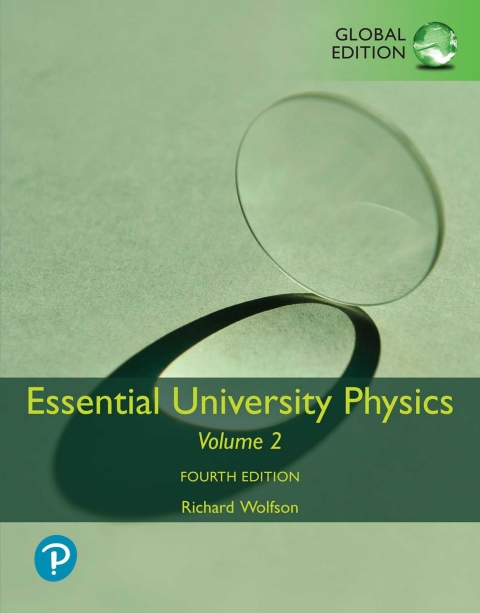Description
Efnisyfirlit
- Title Page
- Copyright Page
- Brief Contents
- Detailed Contents
- About the Author
- Preface to the Instructor
- Preface to the Student
- Video Tutor Demonstrations
- Part Four Electromagnetism
- 20 Electric Charge, Force, and Field
- 20.1 Electric Charge
- 20.2 Coulomb’s Law
- 20.3 The Electric Field
- 20.4 Fields of Charge Distributions
- 20.5 Matter in Electric Fields
- 21 Gauss’s Law
- 21.1 Electric Field Lines
- 21.2 Electric Field and Electric Flux
- 21.3 Gauss’s Law
- 21.4 Using Gauss’s Law
- 21.5 Fields of Arbitrary Charge Distributions
- 21.6 Gauss’s Law and Conductors
- 22 Electric Potential
- 22.1 Electric Potential Difference
- 22.2 Calculating Potential Difference
- 22.3 Potential Difference and the Electric Field
- 22.4 Charged Conductors
- 23 Electrostatic Energy and Capacitors
- 23.1 Electrostatic Energy
- 23.2 Capacitors
- 23.3 Using Capacitors
- 23.4 Energy in the Electric Field
- 24 Electric Current
- 24.1 Electric Current
- 24.2 Conduction Mechanisms
- 24.3 Resistance and Ohm’s Law
- 24.4 Electric Power
- 24.5 Electrical Safety
- 25 Electric Circuits
- 25.1 Circuits, Symbols, and Electromotive Force
- 25.2 Series and Parallel Resistors
- 25.3 Kirchhoff’s Laws and Multiloop Circuits
- 25.4 Electrical Measurements
- 25.5 Capacitors in Circuits
- 26 Magnetism: Force and Field
- 26.1 What Is Magnetism?
- 26.2 Magnetic Force and Field
- 26.3 Charged Particles in Magnetic Fields
- 26.4 The Magnetic Force on a Current
- 26.5 Origin of the Magnetic Field
- 26.6 Magnetic Dipoles
- 26.7 Magnetic Matter
- 26.8 Ampère’s Law
- 27 Electromagnetic Induction
- 27.1 Induced Currents
- 27.2 Faraday’s Law
- 27.3 Induction and Energy
- 27.4 Inductance
- 27.5 Magnetic Energy
- 27.6 Induced Electric Fields
- 28 Alternating-current Circuits
- 28.1 Alternating Current
- 28.2 Circuit Elements in Ac Circuits
- 28.3 LC Circuits
- 28.4 Driven RLC Circuits and Resonance
- 28.5 Power in AC Circuits
- 28.6 Transformers and Power Supplies
- 29 Maxwell’s Equations and Electromagnetic Waves
- 29.1 The Four Laws of Electromagnetism
- 29.2 Ambiguity in Ampère’s Law
- 29.3 Maxwell’s Equations
- 29.4 Electromagnetic Waves
- 29.5 Properties of Electromagnetic Waves
- 29.6 The Electromagnetic Spectrum
- 29.7 Producing Electromagnetic Waves
- 29.8 Energy and Momentum in Electromagnetic Waves
- Part Five Optics
- 30 Reflection and Refraction
- 30.1 Reflection
- 30.2 Refraction
- 30.3 Total Internal Reflection
- 30.4 Dispersion
- 31 Images and Optical Instruments
- 31.1 Images with Mirrors
- 31.2 Images with Lenses
- 31.3 Refraction in Lenses: the Details
- 31.4 Optical Instruments
- 32 Interference and Diffraction
- 32.1 Coherence and Interference
- 32.2 Double-Slit Interference
- 32.3 Multiple-Slit Interference and Diffraction Gratings
- 32.4 Interferometry
- 32.5 Huygens’ Principle and Diffraction
- 32.6 The Diffraction Limit
- Part Six Modern Physics
- 33 Relativity
- 33.1 Speed c Relative to What?
- 33.2 Matter, Motion, and the Ether
- 33.3 Special Relativity
- 33.4 Space and Time in Relativity
- 33.5 Simultaneity Is Relative
- 33.6 The Lorentz Transformations
- 33.7 Energy and Momentum in Relativity
- 33.8 Electromagnetism and Relativity
- 33.9 General Relativity
- 34 Particles and Waves
- 34.1 Toward Quantum Theory
- 34.2 Blackbody Radiation
- 34.3 Photons
- 34.4 Atomic Spectra and the Bohr Atom
- 34.5 Matter Waves
- 34.6 the Uncertainty Principle
- 34.7 Complementarity
- 35 Quantum Mechanics
- 35.1 Particles, Waves, and Probability
- 35.2 The Schrödinger Equation
- 35.3 Particles and Potentials
- 35.4 Quantum Mechanics in Three Dimensions
- 35.5 Relativistic Quantum Mechanics
- 36 Atomic Physics
- 36.1 The Hydrogen Atom
- 36.2 Electron Spin
- 36.3 The Exclusion Principle
- 36.4 Multielectron Atoms and the Periodic Table
- 36.5 Transitions and Atomic Spectra
- 37 Molecules and Solids
- 37.1 Molecular Bonding
- 37.2 Molecular Energy Levels
- 37.3 Solids
- 37.4 Superconductivity
- 38 Nuclear Physics
- 38.1 Elements, Isotopes, and Nuclear Structure
- 38.2 Radioactivity
- 38.3 Binding Energy and Nucleosynthesis
- 38.4 Nuclear Fission
- 38.5 Nuclear Fusion
- 39 From Quarks to the Cosmos
- 39.1 Particles and Forces
- 39.2 Particles and More Particles
- 39.3 Quarks and the Standard Model
- 39.4 Unification
- 39.5 The Evolving Universe
- Appendices
- Appendix A Mathematics
- Appendix B The International Systemof Units (SI)
- Appendix C Conversion Factors
- Appendix D The Elements
- Appendix E Astrophysical Data
- Answers to Odd-Numbered Problems
- Credits
- Index







Reviews
There are no reviews yet.